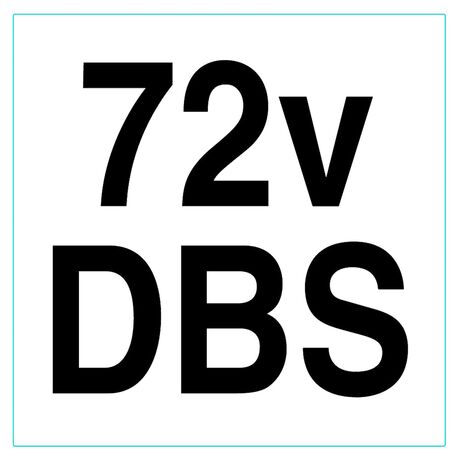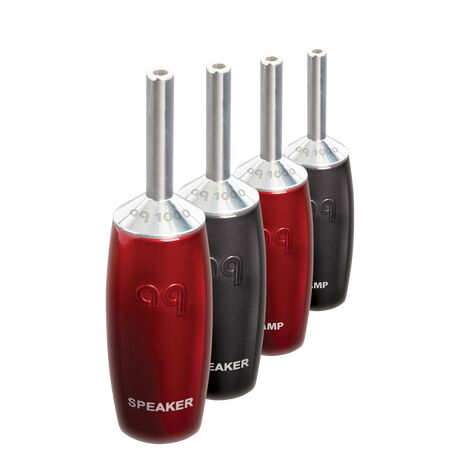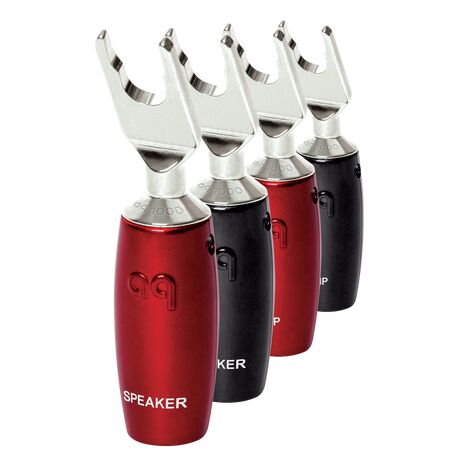Description
Robin Hood ZERO Speaker Cables, by AudioQuest.
Building on a solid base of tried and true AudioQuest technologies, the Robin Hood design team focused on addressing one of the most vexing issues plaguing speaker cable design - the mismatch between the amplifier source impedance and the speaker load impedance. By eliminating the speaker cable’s characteristic impedance (ZERO Technology), current compression and distortion of the signal/current transient are significantly reduced. The result is dynamic contrast, transient response, and bass slam that are rendered seemingly without effort, because the cable is not electrically impeding the music.
Robin Hood ZERO cables are cold-welded to AudioQuest 1000 Series extremely pure Red Copper multi-spades or bananas plugs. The bare copper is submerged (hung) in a vat of pure silver instead of being tumbled in a lower-grade solution. AudioQuest speaker breakouts and plug casings are not metal in order not to induce RF Noise into the conductors.
Features
ZERO-Tech For Uncompressed Current Transfer & Linear Noise-Dissipation - The only complete way to eliminate characteristic-impedance mismatches between a cable and the attached source and load is for the cable not to have any fixed characteristic-impedance value. ZERO-Tech accomplishes this by eliminating interaction between the insulation (dielectric) and the cable’s conductors—enabling uncompressed current transfer. All-important transient current is unrestricted, and RF Noise-Dissipation is linearized (consistent octave to octave).
RF/ND-Tech (Radio-Frequency Ground-Noise Dissipation) - Though a cable’s ground leads are integral to a component’s signal transmission, they also act as an antenna. Thus, they are subject to induced Radio-Frequency (RF) noise. RF noise is a parasitic signal that is typically coupled directly into a system’s most sensitive audio/video circuits. AudioQuest’s RF-on-ground Noise-Dissipation (RF/ND-Tech) greatly reduces resulting distortion and signal masking, yielding unprecedented levels of Noise-Dissipation across the widest bandwidth (range) of radio frequencies possible. Our unique circuit topology uses a common-mode phase-cancelling array, providing linear noise dissipation across the entire length of the cable.
Solid Perfect-Surface Copper+ (PSC+) Conductors - Solid conductors prevent strand-interaction, a major source of dynamic distortion. Extreme-purity PSC+ solid copper minimizes distortion caused by grain boundaries, and, when direction-controlled for surface asymmetry, facilitates crucial Radio-Frequency Noise-Dissipation.
72v Dielectric-Bias System with Level-X Radio-Frequency Trap (DBS) - All insulation is also a dielectric whose electrical properties affect the integrity of the signal. When the insulation is unbiased, dielectric-involvement (absorption and non-linear release of energy back into the signal flow) causes different amounts of time delay (phase shift) for different frequencies and energy levels, which is a significant problem for very time-sensitive multi-octave audio. AudioQuest’s multi-patented DBS creates a strong, stable electrostatic field that saturates and polarizes (organizes) the molecules of the insulation. This minimizes the nonlinear time delays, resulting in clearer sound emerging from a “blacker” background. The Level-X RF Trap (a technology developed for AudioQuest’s Niagara Series of power products) in the DBS battery pack “pulls” RF Noise out of the cable, preventing RF from infiltrating the electronics. DBS Pack batteries last about 10 years. Use the test button to verify condition.
Directionality - All drawn metal strands or conductors have a non-symmetrical, and therefore directional, grain structure. AudioQuest controls the resulting RF impedance variation so that noise is drained away from where it will cause distortion. The correct direction is determined by listening to every batch of metal conductors used in every AudioQuest audio cable. When applicable, arrows are clearly marked on the connectors to ensure superior sound quality. For most models of AQ cable, the arrows not only indicate the direction that optimizes metal-directionality as part of Noise-Dissipation, but also indicates non-symmetrical attachment of shield and GND in order to optimize full-system performance.
Carbon-Based Linearized Noise-Dissipation System - Today’s environment is saturated with radio-frequency noise that is extremely difficult to filter or reject. The frequencies of this noise from satellites, cellular towers, and Bluetooth, etc., are so extremely narrow that a conventional shield, or a series or shunt filter, is wholly inadequate. Much of the low-level signal that carries the harmonics and spatial cues that define high-resolution audio is masked by induced radio-frequency noise. AQ’s comprehensive Linearized Noise-Dissipation System combines multiple shields and a carbon-based linearized resistive network that turns most of this noise into heat. By linearized, we mean that the system is equally effective across extremely wide bandwidth, rather than at selected frequencies only, as is more common. The remaining energy is effectively drained away from the sensitive amplifier circuits via directionally controlled signal and shield conductors.
More Information
Delivery and Returns
| Shipping method | Delivery Time | Cost |
|---|
Please be advised that we may upgrade your delivery to a better service if we deem it appropriate to designated destinations at no additional cost. Please view our returns policy.
*Quoted delivery times are estimates and apply to normal working days for in stock items.
Information
- Single Wire
Cable Information
- Speaker Cables
Tags
Worldwide Shipping
- Free UK First Class shipping on orders £ 99+
- UK shipping from: £ 1.95
- EU shipping from: £ 5.99
- International shipping from: £ 5.99
- View shipping rates for your country
Payment Methods
- Paypal
- Visa
- Mastercard
- All other major credit/debit cards













